Europe · Iceland · Regions · Western Europe
Winter is coming for Iceland
Winter is coming! A phrase adopted by Game of Thrones many years ago, but also something often muttered by the locals when the first snow falls in the autumn months. For the locals, it spells the end of harvest season and the start of a difficult winter. For tourists, it’s the beginning of a winter wonderland.
This months post is going to focus on some of the reasons winter in Iceland is revered by so many, despite the cold. If things improve before the winter snow disappears in March then perhaps popping over to Iceland could be an option for you. But for now, let’s consider this aspirational and educational. It’s all most of us can hope for right now sadly.
Autumn is leaving
This autumn, Icelanders have been quite lucky. The weather has been quite warm, calm and plenty of nights with Northern Lights. Very little snow has fallen in the lower regions of the country meaning some harvests have been very fruitful, though there are of course a lot of other factors. On a personal note, I managed to get out with a few friends last week to plant some trees (much needed in Iceland).
 These last few weeks of autumn, before the ground freezes, are ideal planting time. Mainly because it’s nice and wet, the free-roaming sheep are back in their sheds for winter, and the gluttonous birds have migrated south for winter. In our efforts, we planted around 10,000 native Birch trees in under a week. Not bad for newbies. The Icelandic government have actually set a target of planting 4,000,000 new trees per year until 2100 so I feel like I’ve done my part this year at least.
By the time autumn truly leaves us (pardon the pun) there are few animals left in the countryside. 90% of the birdlife migrate south, leaving behind a few solitary geese, swans and fulmars. All the whales and orcas are gone too, with the exception of a few dolphins and one family of killer whales who remain near the Snaefellsnes Peninsula year round. Any barnyard animals that roamed free during the summer, or in the expansive fields, are now tucked away snuggly in their warm barns for protection. The only new arrivals in winter are the Reindeer. New in the sense that they tend to hide up in the mountains to escape the summer heat (you heard that right), but travel towards sea-level in winter when it’s cooler.
Winter is blue
The first snow rarely signifies the end of autumn considering how turbulent Iceland’s weather patterns can get. In fact, I had the pleasure of being snowed on in August last year, followed by 2 weeks of t-shirt weather. So I would suggest that the first real day of winter is actually when the local ice cave experts announce that the winter blue ice caves are safe to enter. Basically, blue ice caves can only be safely explored when the average temperature is low enough to stop them from melting and collapsing. On a scheduling basis, this is often the first week of November, but it can sometimes be earlier or later.
These last few weeks of autumn, before the ground freezes, are ideal planting time. Mainly because it’s nice and wet, the free-roaming sheep are back in their sheds for winter, and the gluttonous birds have migrated south for winter. In our efforts, we planted around 10,000 native Birch trees in under a week. Not bad for newbies. The Icelandic government have actually set a target of planting 4,000,000 new trees per year until 2100 so I feel like I’ve done my part this year at least.
By the time autumn truly leaves us (pardon the pun) there are few animals left in the countryside. 90% of the birdlife migrate south, leaving behind a few solitary geese, swans and fulmars. All the whales and orcas are gone too, with the exception of a few dolphins and one family of killer whales who remain near the Snaefellsnes Peninsula year round. Any barnyard animals that roamed free during the summer, or in the expansive fields, are now tucked away snuggly in their warm barns for protection. The only new arrivals in winter are the Reindeer. New in the sense that they tend to hide up in the mountains to escape the summer heat (you heard that right), but travel towards sea-level in winter when it’s cooler.
Winter is blue
The first snow rarely signifies the end of autumn considering how turbulent Iceland’s weather patterns can get. In fact, I had the pleasure of being snowed on in August last year, followed by 2 weeks of t-shirt weather. So I would suggest that the first real day of winter is actually when the local ice cave experts announce that the winter blue ice caves are safe to enter. Basically, blue ice caves can only be safely explored when the average temperature is low enough to stop them from melting and collapsing. On a scheduling basis, this is often the first week of November, but it can sometimes be earlier or later.
 Glaciers are safe to walk on all year round. In fact, it’s from the movement and melting of the ice in summer that creates these beautiful blue ice sculptures in winter. But going ‘into’ a glacier is a winter only activity when they are temporarily frozen in time. Locked in place if you will. But this is only possible for a few months until the spring warmth melts them away. Every winter is unique and every ice cave is different. So even if you’ve visited an ice cave before it doesn’t mean it’ll be the same experience next time.
Winter is white
This seems like a fairly obvious title, though it is quite misleading. Yes, snowfalls on the mountains at the end of autumn and remains there until spring. So you are technically guaranteed a winter wonderland view. However, Iceland despite its near Arctic location, is blessed with an unseasonably warm winter. This is due to the warming effects of the gulf stream. The average temperature sits around zero Celcius (32F) in January, the coldest month of the year. Surprisingly it is around the same as New York.
Glaciers are safe to walk on all year round. In fact, it’s from the movement and melting of the ice in summer that creates these beautiful blue ice sculptures in winter. But going ‘into’ a glacier is a winter only activity when they are temporarily frozen in time. Locked in place if you will. But this is only possible for a few months until the spring warmth melts them away. Every winter is unique and every ice cave is different. So even if you’ve visited an ice cave before it doesn’t mean it’ll be the same experience next time.
Winter is white
This seems like a fairly obvious title, though it is quite misleading. Yes, snowfalls on the mountains at the end of autumn and remains there until spring. So you are technically guaranteed a winter wonderland view. However, Iceland despite its near Arctic location, is blessed with an unseasonably warm winter. This is due to the warming effects of the gulf stream. The average temperature sits around zero Celcius (32F) in January, the coldest month of the year. Surprisingly it is around the same as New York.
 So if you stay in Iceland for at least a week in winter you are likely to encounter snow on the ground, but it is by no means guaranteed. Fingers crossed you come when the sun is shining and the ground is white with fresh snow.
Winter is turbulent
This of course is in relation to the weather. After all, you can’t get a winter wonderland without some snow. In Iceland, that snow can sometimes be accompanied with very strong, cold winds. Thankfully, Iceland’s weather is turbulent in both directions. For every storm with accompanying 100mph winds you are often treated to blue skies and warm air. In fact, some parts of Iceland can see temperature fluctuations in winter that allow for a few days of t-shirt weather. Honestly! A few years ago, thanks to a strange warm front there were places that reported temperatures close to 20 Celcius. That’s hard to find even in the summer in Iceland. A few days later it was minus 10 Celcius. I told you it was turbulent!
So if you stay in Iceland for at least a week in winter you are likely to encounter snow on the ground, but it is by no means guaranteed. Fingers crossed you come when the sun is shining and the ground is white with fresh snow.
Winter is turbulent
This of course is in relation to the weather. After all, you can’t get a winter wonderland without some snow. In Iceland, that snow can sometimes be accompanied with very strong, cold winds. Thankfully, Iceland’s weather is turbulent in both directions. For every storm with accompanying 100mph winds you are often treated to blue skies and warm air. In fact, some parts of Iceland can see temperature fluctuations in winter that allow for a few days of t-shirt weather. Honestly! A few years ago, thanks to a strange warm front there were places that reported temperatures close to 20 Celcius. That’s hard to find even in the summer in Iceland. A few days later it was minus 10 Celcius. I told you it was turbulent!
 My recommendation is that in winter you should aim to take things slowly and not pack in too many activities. Travel can be understandably slow on certain days and activities may need moved. If you stay long enough you are likely to encounter all 4 seasons. On the days where the clouds are gone and the sun barely rises in the sky, you will be treated to the best photography light of your life.
Winter is golden
For the avid photographer out there, I’m sure you’ve heard of the ‘golden hour’. An hour at the end of the day before the sun sets when the light is atmospheric and golden. Perfect for photography. What if I told you that Iceland had a ‘golden day’ as opposed to a golden hour. This is very true. True because the sun, even at midday, barely rises above the horizon all day. It’s also true that you only get 4-5 hours of direct sunlight in the darker months of winter. But for me, if those 4-5 hours are filled with golden light and an incredible sunrise and sunset then I’m happy to take the added darkness at night. Especially if that darkness brings with it the Northern Lights.
My recommendation is that in winter you should aim to take things slowly and not pack in too many activities. Travel can be understandably slow on certain days and activities may need moved. If you stay long enough you are likely to encounter all 4 seasons. On the days where the clouds are gone and the sun barely rises in the sky, you will be treated to the best photography light of your life.
Winter is golden
For the avid photographer out there, I’m sure you’ve heard of the ‘golden hour’. An hour at the end of the day before the sun sets when the light is atmospheric and golden. Perfect for photography. What if I told you that Iceland had a ‘golden day’ as opposed to a golden hour. This is very true. True because the sun, even at midday, barely rises above the horizon all day. It’s also true that you only get 4-5 hours of direct sunlight in the darker months of winter. But for me, if those 4-5 hours are filled with golden light and an incredible sunrise and sunset then I’m happy to take the added darkness at night. Especially if that darkness brings with it the Northern Lights.
 Winter is green
You will rightly assume that I’m referring to the green hue of the Northern Lights when I say winter is green in Iceland. And yes, on the nights that the Northern Lights are shining this is the dominant colour.
Winter is green
You will rightly assume that I’m referring to the green hue of the Northern Lights when I say winter is green in Iceland. And yes, on the nights that the Northern Lights are shining this is the dominant colour.
 If you haven’t seen the dancing aurora before then Iceland should be at the top of your list. But, make sure to allocate plenty of nights to search for them as the weather and the strength can play a big part in whether or not you are successful.
If you haven’t seen the dancing aurora before then Iceland should be at the top of your list. But, make sure to allocate plenty of nights to search for them as the weather and the strength can play a big part in whether or not you are successful.
 However, Iceland remains green in winter for another reason too. The moss! The nationally protected moss. Don’t even think about walking on it. Iceland’s lack of trees are more than made up for with their lava fields caked in bright green moss. The moss keeps its green colour all year, as long as there is moisture…and trust me that is rarely a problem in Iceland. So if snow hasn’t enveloped the ground then the moss will surely be the focal point of the landscape. Despite the moss’s ability to reduce hardy volcanic rock into soil over a few decades it is rather fragile. So fragile in fact that if you step on it you are likely to stop any real growth that year. If you step on the same spot over and over it can take up to 70 years to recover. That’s a lot of degradation if you add in a few million tourists each year. Luckily, the tourists who frequent Iceland’s shores are mostly respectful of the rules and Iceland’s fragile eco-system remains untouched in many places.
Winter is coming
So that is my brief synopsis of winter as it approaches in the coming weeks. In short, the winter experience tends to start in November and end at the end of March. During that time temperatures can plummet to minus 20C. Daylight hours get as low as 4 hours. The Northern Lights bleach the sky. And the snow covers the surroundings. It sounds delightful to me. Just make sure to wrap up warm.
However, Iceland remains green in winter for another reason too. The moss! The nationally protected moss. Don’t even think about walking on it. Iceland’s lack of trees are more than made up for with their lava fields caked in bright green moss. The moss keeps its green colour all year, as long as there is moisture…and trust me that is rarely a problem in Iceland. So if snow hasn’t enveloped the ground then the moss will surely be the focal point of the landscape. Despite the moss’s ability to reduce hardy volcanic rock into soil over a few decades it is rather fragile. So fragile in fact that if you step on it you are likely to stop any real growth that year. If you step on the same spot over and over it can take up to 70 years to recover. That’s a lot of degradation if you add in a few million tourists each year. Luckily, the tourists who frequent Iceland’s shores are mostly respectful of the rules and Iceland’s fragile eco-system remains untouched in many places.
Winter is coming
So that is my brief synopsis of winter as it approaches in the coming weeks. In short, the winter experience tends to start in November and end at the end of March. During that time temperatures can plummet to minus 20C. Daylight hours get as low as 4 hours. The Northern Lights bleach the sky. And the snow covers the surroundings. It sounds delightful to me. Just make sure to wrap up warm.
 See you soon!
Ryan Connolly is Co-Founder of Hidden Iceland. Hidden Iceland specialises in private trips, taking you to some of the hidden gems of Iceland with a passionate and experienced guide.
If you would like to be a guest blogger on A Luxury Travel Blog in order to raise your profile, please contact us.
See you soon!
Ryan Connolly is Co-Founder of Hidden Iceland. Hidden Iceland specialises in private trips, taking you to some of the hidden gems of Iceland with a passionate and experienced guide.
If you would like to be a guest blogger on A Luxury Travel Blog in order to raise your profile, please contact us.
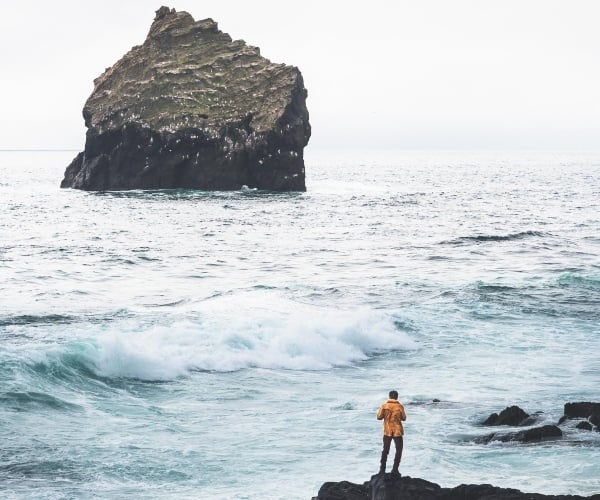 These last few weeks of autumn, before the ground freezes, are ideal planting time. Mainly because it’s nice and wet, the free-roaming sheep are back in their sheds for winter, and the gluttonous birds have migrated south for winter. In our efforts, we planted around 10,000 native Birch trees in under a week. Not bad for newbies. The Icelandic government have actually set a target of planting 4,000,000 new trees per year until 2100 so I feel like I’ve done my part this year at least.
By the time autumn truly leaves us (pardon the pun) there are few animals left in the countryside. 90% of the birdlife migrate south, leaving behind a few solitary geese, swans and fulmars. All the whales and orcas are gone too, with the exception of a few dolphins and one family of killer whales who remain near the Snaefellsnes Peninsula year round. Any barnyard animals that roamed free during the summer, or in the expansive fields, are now tucked away snuggly in their warm barns for protection. The only new arrivals in winter are the Reindeer. New in the sense that they tend to hide up in the mountains to escape the summer heat (you heard that right), but travel towards sea-level in winter when it’s cooler.
Winter is blue
The first snow rarely signifies the end of autumn considering how turbulent Iceland’s weather patterns can get. In fact, I had the pleasure of being snowed on in August last year, followed by 2 weeks of t-shirt weather. So I would suggest that the first real day of winter is actually when the local ice cave experts announce that the winter blue ice caves are safe to enter. Basically, blue ice caves can only be safely explored when the average temperature is low enough to stop them from melting and collapsing. On a scheduling basis, this is often the first week of November, but it can sometimes be earlier or later.
These last few weeks of autumn, before the ground freezes, are ideal planting time. Mainly because it’s nice and wet, the free-roaming sheep are back in their sheds for winter, and the gluttonous birds have migrated south for winter. In our efforts, we planted around 10,000 native Birch trees in under a week. Not bad for newbies. The Icelandic government have actually set a target of planting 4,000,000 new trees per year until 2100 so I feel like I’ve done my part this year at least.
By the time autumn truly leaves us (pardon the pun) there are few animals left in the countryside. 90% of the birdlife migrate south, leaving behind a few solitary geese, swans and fulmars. All the whales and orcas are gone too, with the exception of a few dolphins and one family of killer whales who remain near the Snaefellsnes Peninsula year round. Any barnyard animals that roamed free during the summer, or in the expansive fields, are now tucked away snuggly in their warm barns for protection. The only new arrivals in winter are the Reindeer. New in the sense that they tend to hide up in the mountains to escape the summer heat (you heard that right), but travel towards sea-level in winter when it’s cooler.
Winter is blue
The first snow rarely signifies the end of autumn considering how turbulent Iceland’s weather patterns can get. In fact, I had the pleasure of being snowed on in August last year, followed by 2 weeks of t-shirt weather. So I would suggest that the first real day of winter is actually when the local ice cave experts announce that the winter blue ice caves are safe to enter. Basically, blue ice caves can only be safely explored when the average temperature is low enough to stop them from melting and collapsing. On a scheduling basis, this is often the first week of November, but it can sometimes be earlier or later.
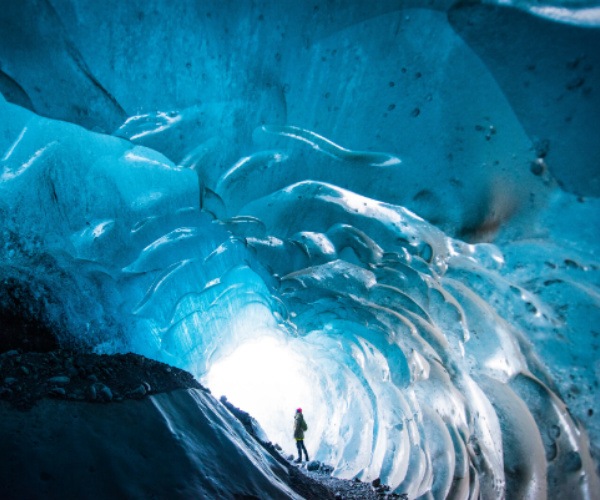 Glaciers are safe to walk on all year round. In fact, it’s from the movement and melting of the ice in summer that creates these beautiful blue ice sculptures in winter. But going ‘into’ a glacier is a winter only activity when they are temporarily frozen in time. Locked in place if you will. But this is only possible for a few months until the spring warmth melts them away. Every winter is unique and every ice cave is different. So even if you’ve visited an ice cave before it doesn’t mean it’ll be the same experience next time.
Winter is white
This seems like a fairly obvious title, though it is quite misleading. Yes, snowfalls on the mountains at the end of autumn and remains there until spring. So you are technically guaranteed a winter wonderland view. However, Iceland despite its near Arctic location, is blessed with an unseasonably warm winter. This is due to the warming effects of the gulf stream. The average temperature sits around zero Celcius (32F) in January, the coldest month of the year. Surprisingly it is around the same as New York.
Glaciers are safe to walk on all year round. In fact, it’s from the movement and melting of the ice in summer that creates these beautiful blue ice sculptures in winter. But going ‘into’ a glacier is a winter only activity when they are temporarily frozen in time. Locked in place if you will. But this is only possible for a few months until the spring warmth melts them away. Every winter is unique and every ice cave is different. So even if you’ve visited an ice cave before it doesn’t mean it’ll be the same experience next time.
Winter is white
This seems like a fairly obvious title, though it is quite misleading. Yes, snowfalls on the mountains at the end of autumn and remains there until spring. So you are technically guaranteed a winter wonderland view. However, Iceland despite its near Arctic location, is blessed with an unseasonably warm winter. This is due to the warming effects of the gulf stream. The average temperature sits around zero Celcius (32F) in January, the coldest month of the year. Surprisingly it is around the same as New York.
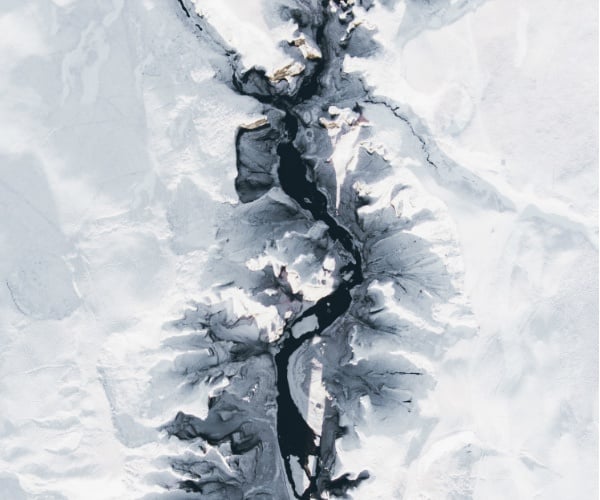 So if you stay in Iceland for at least a week in winter you are likely to encounter snow on the ground, but it is by no means guaranteed. Fingers crossed you come when the sun is shining and the ground is white with fresh snow.
Winter is turbulent
This of course is in relation to the weather. After all, you can’t get a winter wonderland without some snow. In Iceland, that snow can sometimes be accompanied with very strong, cold winds. Thankfully, Iceland’s weather is turbulent in both directions. For every storm with accompanying 100mph winds you are often treated to blue skies and warm air. In fact, some parts of Iceland can see temperature fluctuations in winter that allow for a few days of t-shirt weather. Honestly! A few years ago, thanks to a strange warm front there were places that reported temperatures close to 20 Celcius. That’s hard to find even in the summer in Iceland. A few days later it was minus 10 Celcius. I told you it was turbulent!
So if you stay in Iceland for at least a week in winter you are likely to encounter snow on the ground, but it is by no means guaranteed. Fingers crossed you come when the sun is shining and the ground is white with fresh snow.
Winter is turbulent
This of course is in relation to the weather. After all, you can’t get a winter wonderland without some snow. In Iceland, that snow can sometimes be accompanied with very strong, cold winds. Thankfully, Iceland’s weather is turbulent in both directions. For every storm with accompanying 100mph winds you are often treated to blue skies and warm air. In fact, some parts of Iceland can see temperature fluctuations in winter that allow for a few days of t-shirt weather. Honestly! A few years ago, thanks to a strange warm front there were places that reported temperatures close to 20 Celcius. That’s hard to find even in the summer in Iceland. A few days later it was minus 10 Celcius. I told you it was turbulent!
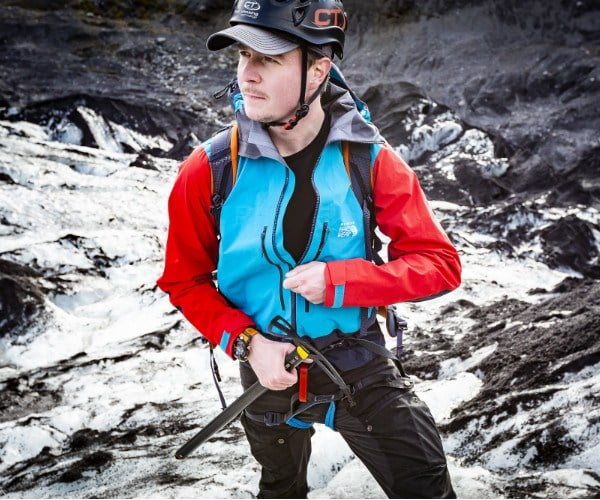 My recommendation is that in winter you should aim to take things slowly and not pack in too many activities. Travel can be understandably slow on certain days and activities may need moved. If you stay long enough you are likely to encounter all 4 seasons. On the days where the clouds are gone and the sun barely rises in the sky, you will be treated to the best photography light of your life.
Winter is golden
For the avid photographer out there, I’m sure you’ve heard of the ‘golden hour’. An hour at the end of the day before the sun sets when the light is atmospheric and golden. Perfect for photography. What if I told you that Iceland had a ‘golden day’ as opposed to a golden hour. This is very true. True because the sun, even at midday, barely rises above the horizon all day. It’s also true that you only get 4-5 hours of direct sunlight in the darker months of winter. But for me, if those 4-5 hours are filled with golden light and an incredible sunrise and sunset then I’m happy to take the added darkness at night. Especially if that darkness brings with it the Northern Lights.
My recommendation is that in winter you should aim to take things slowly and not pack in too many activities. Travel can be understandably slow on certain days and activities may need moved. If you stay long enough you are likely to encounter all 4 seasons. On the days where the clouds are gone and the sun barely rises in the sky, you will be treated to the best photography light of your life.
Winter is golden
For the avid photographer out there, I’m sure you’ve heard of the ‘golden hour’. An hour at the end of the day before the sun sets when the light is atmospheric and golden. Perfect for photography. What if I told you that Iceland had a ‘golden day’ as opposed to a golden hour. This is very true. True because the sun, even at midday, barely rises above the horizon all day. It’s also true that you only get 4-5 hours of direct sunlight in the darker months of winter. But for me, if those 4-5 hours are filled with golden light and an incredible sunrise and sunset then I’m happy to take the added darkness at night. Especially if that darkness brings with it the Northern Lights.
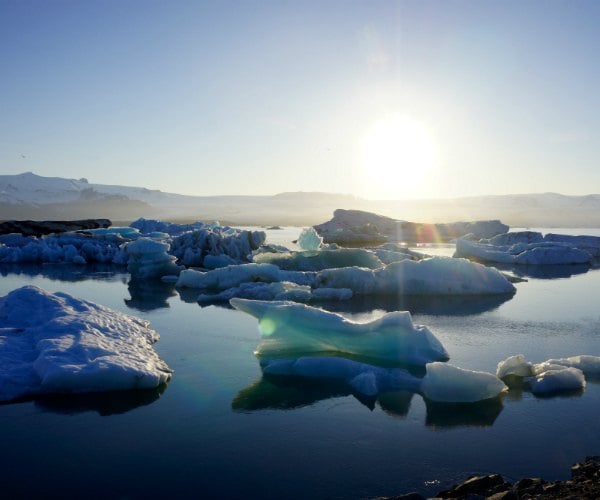 Winter is green
You will rightly assume that I’m referring to the green hue of the Northern Lights when I say winter is green in Iceland. And yes, on the nights that the Northern Lights are shining this is the dominant colour.
Winter is green
You will rightly assume that I’m referring to the green hue of the Northern Lights when I say winter is green in Iceland. And yes, on the nights that the Northern Lights are shining this is the dominant colour.
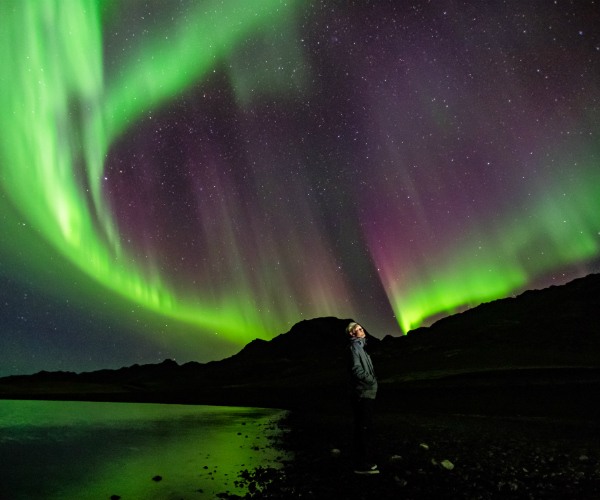 If you haven’t seen the dancing aurora before then Iceland should be at the top of your list. But, make sure to allocate plenty of nights to search for them as the weather and the strength can play a big part in whether or not you are successful.
If you haven’t seen the dancing aurora before then Iceland should be at the top of your list. But, make sure to allocate plenty of nights to search for them as the weather and the strength can play a big part in whether or not you are successful.
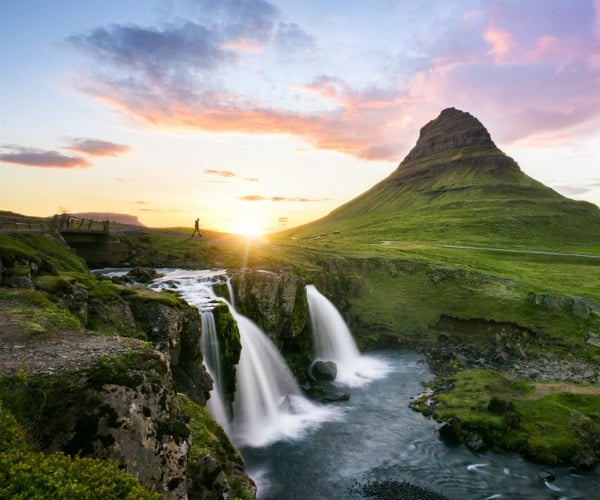 However, Iceland remains green in winter for another reason too. The moss! The nationally protected moss. Don’t even think about walking on it. Iceland’s lack of trees are more than made up for with their lava fields caked in bright green moss. The moss keeps its green colour all year, as long as there is moisture…and trust me that is rarely a problem in Iceland. So if snow hasn’t enveloped the ground then the moss will surely be the focal point of the landscape. Despite the moss’s ability to reduce hardy volcanic rock into soil over a few decades it is rather fragile. So fragile in fact that if you step on it you are likely to stop any real growth that year. If you step on the same spot over and over it can take up to 70 years to recover. That’s a lot of degradation if you add in a few million tourists each year. Luckily, the tourists who frequent Iceland’s shores are mostly respectful of the rules and Iceland’s fragile eco-system remains untouched in many places.
Winter is coming
So that is my brief synopsis of winter as it approaches in the coming weeks. In short, the winter experience tends to start in November and end at the end of March. During that time temperatures can plummet to minus 20C. Daylight hours get as low as 4 hours. The Northern Lights bleach the sky. And the snow covers the surroundings. It sounds delightful to me. Just make sure to wrap up warm.
However, Iceland remains green in winter for another reason too. The moss! The nationally protected moss. Don’t even think about walking on it. Iceland’s lack of trees are more than made up for with their lava fields caked in bright green moss. The moss keeps its green colour all year, as long as there is moisture…and trust me that is rarely a problem in Iceland. So if snow hasn’t enveloped the ground then the moss will surely be the focal point of the landscape. Despite the moss’s ability to reduce hardy volcanic rock into soil over a few decades it is rather fragile. So fragile in fact that if you step on it you are likely to stop any real growth that year. If you step on the same spot over and over it can take up to 70 years to recover. That’s a lot of degradation if you add in a few million tourists each year. Luckily, the tourists who frequent Iceland’s shores are mostly respectful of the rules and Iceland’s fragile eco-system remains untouched in many places.
Winter is coming
So that is my brief synopsis of winter as it approaches in the coming weeks. In short, the winter experience tends to start in November and end at the end of March. During that time temperatures can plummet to minus 20C. Daylight hours get as low as 4 hours. The Northern Lights bleach the sky. And the snow covers the surroundings. It sounds delightful to me. Just make sure to wrap up warm.
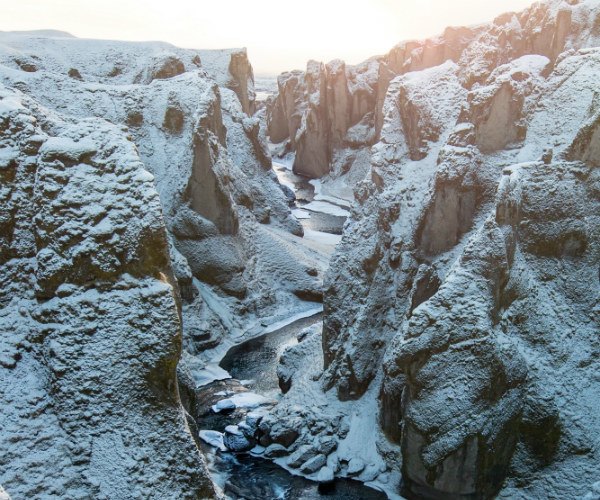 See you soon!
Ryan Connolly is Co-Founder of Hidden Iceland. Hidden Iceland specialises in private trips, taking you to some of the hidden gems of Iceland with a passionate and experienced guide.
If you would like to be a guest blogger on A Luxury Travel Blog in order to raise your profile, please contact us.
See you soon!
Ryan Connolly is Co-Founder of Hidden Iceland. Hidden Iceland specialises in private trips, taking you to some of the hidden gems of Iceland with a passionate and experienced guide.
If you would like to be a guest blogger on A Luxury Travel Blog in order to raise your profile, please contact us.Did you enjoy this article?
Receive similar content direct to your inbox.

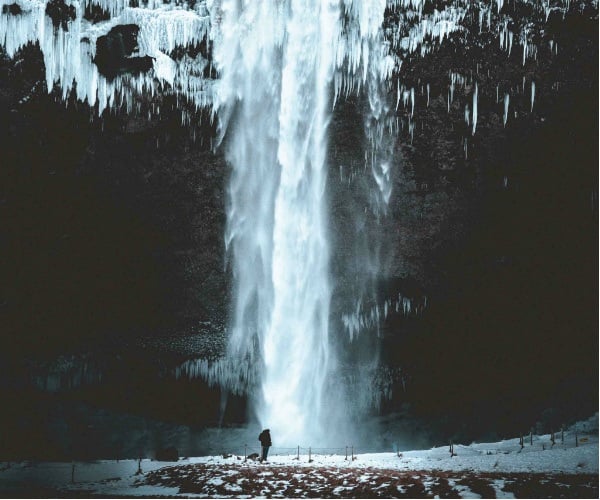

Out of interest what trees did you plant? Which varieties thrive in Iceland? But more importantly which trees does Iceland need?
We planted Birch trees. The Birch was the only native tree that survived the last ice age. These days Iceland predominantly plants Birch, Pine, Rowan and Poplar, with a lower number of conifers, spruce, aspen, fir, cottonwood and larch.
That’s an amazing photo taken inside that glacier. I’ve been inside a glacier in Austria and they had some spectacularly lit ice carvings but I’d prefer to walk in an untouched and natural glacier.
Hi Nick,
Iceland is quite great at preserving these natural structures without the need for human interaction so if you enter a natural ice cave in Iceland you can be sure that it is the same as when it was found.
That picture of the Northern Lights is absolutely amazing and a reminder to me that the Northern Lights is still sat very close to the top of my bucket list, Hopefully soon, once travel gets back to something closer to normal.
Hi Shiela,
Absolutely, the Northern Lights is one of those solitary activities that can be very safely done with social distancing in mind. A pretty isolated activity actually. Perfect.
I love the sea in winter, the picture of the northern lights is really fascinating.
I agree, the icy landscape surrounded by crashing waves is something to behold. Add in the Northern Lights and its a spectacle to remember for the rest of your life.
I like how you described winter in colors. One would normally picture winter scenes in just white and black, since those are the predominant colors of this season. Iceland proves there can be bright colors in winter as well. I’d say the Northern Lights is similar to us in the equatorial regions to rainbows. Hard to come by and very fleeting. Takes a very precise combination of weather anomalies and location to see a rainbow, I’d say. Hopefully we can all travel safely and maybe a bit more freely soon. This year has been very hard for many and we deserve a break and breath of fresh air.
I’ve rarely heard of the Northern Lights being compared to a rainbow before but I guess you are right. In both cases you need the right weather, sun location and a bit of luck. And they are both incredibly beautiful of course too.
Fingers crossed you can travel to Iceland soon.